Texas offers a rich and varied landscape that supports an incredible diversity of birdlife, including many species with striking black plumage. These birds are often seen in forests, grasslands, wetlands, and even city parks. Exploring the many types of black birds in Texas reveals a surprising range of sizes, songs, and behaviors that go far beyond their dark feathers.
Some black birds are known for their bold personalities and loud calls, while others are more secretive and solitary. They play important roles in local ecosystems—controlling insect populations, cleaning up waste, and even pollinating plants. Learning to identify the different types of black birds in Texas can offer a deeper connection to the natural world right outside your door.
This guide introduces 24 unique types of black birds in Texas, each with photos, identification tips, habitat preferences, and feeding habits. Whether you’re spotting them on a backyard feeder or along a nature trail, this list will help you recognize and appreciate these remarkable birds across the state.
Different Types of Black Birds in Texas
Red-winged Blackbird (Agelaius phoeniceus)
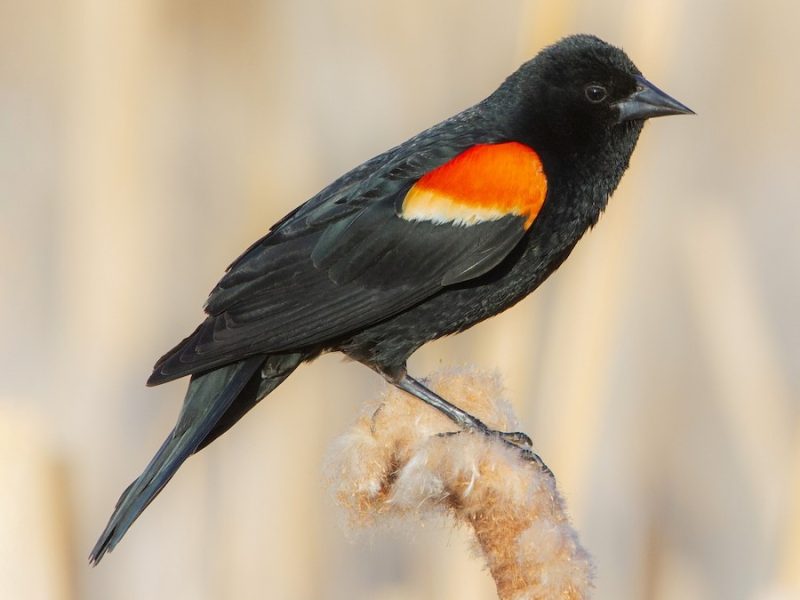
The Red-winged Blackbird is one of the most recognizable blackbirds in Texas, especially known for the striking red and yellow shoulder patches on the males. Males have glossy black feathers contrasted by their bright red epaulets, while females are more subdued with streaky brown plumage for camouflage. Their size is medium, about 7 to 9 inches in length, and they have a sharp, pointed bill ideal for their omnivorous diet.
These birds are commonly found in wetlands, marshes, and open fields throughout Texas, often perching on reeds and cattails. They are highly territorial during breeding season, with males aggressively defending their nesting area by singing loudly and displaying their red shoulder patches. Red-winged Blackbirds can be seen year-round in many parts of Texas, though northern populations may migrate south for winter.
Their diet consists mainly of seeds, grains, and insects, making them beneficial for controlling pest populations in agricultural areas. They also eat small fruits and occasionally forage on the ground or in shallow water. Their social behavior is notable, as they often form large flocks outside of breeding season, which can number in the thousands.
European Starling (Sturnus vulgaris)
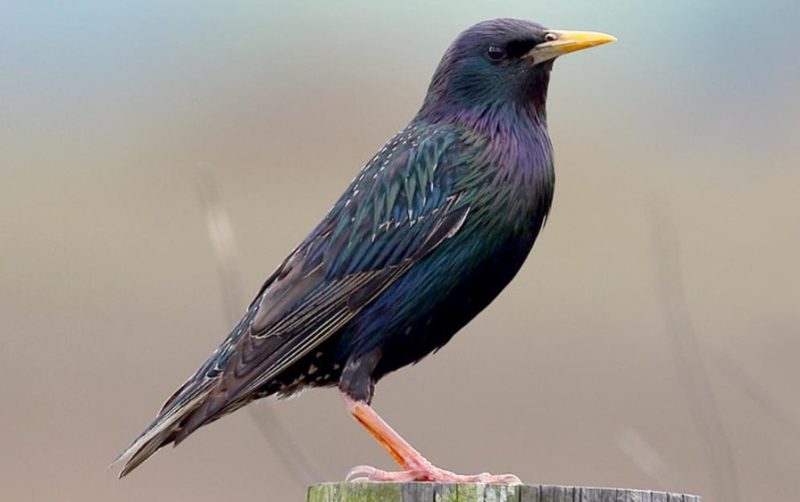
European Starlings are medium-sized birds about 7 to 8 inches long with iridescent black feathers that shimmer with hints of green and purple in sunlight. Their plumage is speckled with white spots, especially in winter, and they have a slender, pointed yellow bill. Starlings are known for their strong, direct flight and highly vocal nature, capable of mimicking other birds and sounds.
Introduced to North America in the 19th century, European Starlings have become widespread in Texas and across the continent. They thrive in a variety of habitats including urban areas, farmlands, parks, and open woodlands. These birds are highly adaptable and often nest in cavities, such as tree holes or man-made structures, sometimes competing with native species.
European Starlings are omnivores with a diet that includes insects, fruits, seeds, and even human food scraps. Their foraging behavior is often seen in large flocks, where they probe the ground or turf for insects and grubs. While their presence is common, they can sometimes be considered a nuisance due to their aggressive competition with native birds and tendency to damage crops.
Brown-headed Cowbird (Molothrus ater)

Brown-headed Cowbirds are distinctive blackbirds with a glossy black body and a rich brown head, measuring around 7 to 8 inches in length. Males exhibit this sharp contrast, while females are more uniformly brown and less flashy. They have a slightly chunky build and a short, thick bill suited for their varied diet. Cowbirds are well known for their brood parasitism behavior, laying eggs in the nests of other bird species.
In Texas, Brown-headed Cowbirds are common across open habitats such as grasslands, pastures, and agricultural fields. They often follow grazing animals or machinery to catch insects disturbed by movement. This species does not build its own nest but instead relies on other birds to raise its young, which can negatively affect host bird populations.
Their diet includes seeds, grains, and a wide variety of insects. They forage on the ground or low vegetation and are often seen in flocks, especially outside the breeding season. Despite their parasitic behavior, Brown-headed Cowbirds play an ecological role by controlling insect populations and contributing to the complexity of local ecosystems.
Common Grackle (Quiscalus quiscula)

The Common Grackle is a large blackbird, measuring 11 to 13 inches long, known for its glossy black plumage with iridescent blues, greens, and purples, especially noticeable in good light. They have long tails, yellow eyes, and a sharp, pointed bill. Their size and iridescence make them stand out among other blackbirds, and their vocalizations include a variety of harsh and melodic calls.
In Texas, Common Grackles are widespread in urban, suburban, and rural areas. They prefer open habitats such as parks, fields, and agricultural lands, often forming large, noisy flocks. During the breeding season, they nest in trees or shrubs and sometimes use cavities or old nests of other birds. These birds are highly adaptable and thrive in human-altered environments.
Common Grackles are omnivores, eating insects, small fish, seeds, fruits, and even eggs or nestlings of other birds on occasion. Their opportunistic feeding behavior allows them to exploit many food sources. They are often seen foraging on lawns, parking lots, or farmland, and their large flocks can sometimes cause damage to crops or become a nuisance in urban areas.
Great-tailed Grackle (Quiscalus mexicanus)

Great-tailed Grackles are among the largest blackbirds in Texas, measuring 15 to 18 inches long, with males notably bigger than females. Males are glossy black with a long, keel-shaped tail, while females are smaller and brownish with streaked underparts. Their bright yellow eyes and loud, varied calls make them easily identifiable. They have a distinctive, confident posture and are often seen strutting in groups.
These grackles are common in southern Texas and are expanding their range northward. They favor urban areas, wetlands, and agricultural fields and are frequently spotted near water sources like lakes, rivers, and irrigation canals. They nest in trees, shrubs, or on man-made structures, often in colonies. Great-tailed Grackles are very social birds, often forming large flocks that gather noisily.
Their diet is highly varied, consisting of insects, small vertebrates, grains, fruits, and human food scraps. They are intelligent and resourceful foragers, known for stealing food and scavenging. Their adaptability to urban environments and aggressive behavior often bring them into close contact with people, where they are both admired and sometimes considered pests.
Boat-tailed Grackle (Quiscalus major)
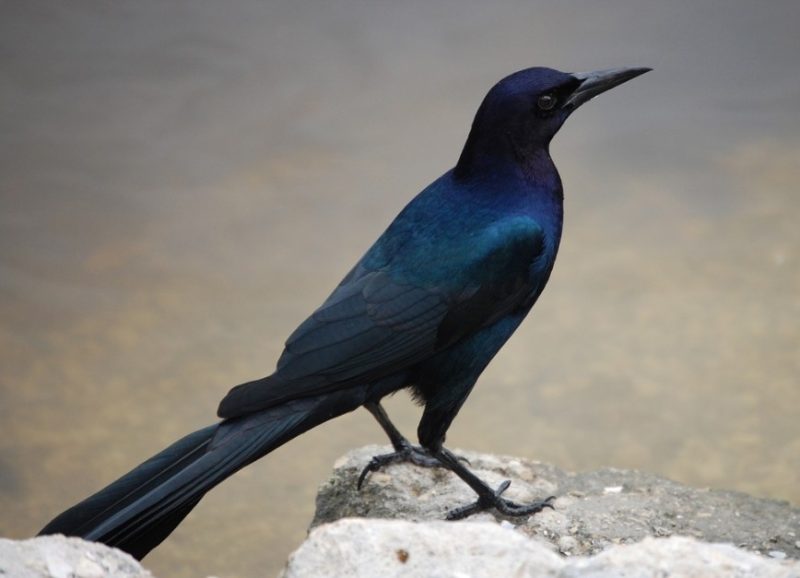
The Boat-tailed Grackle is a large blackbird closely related to the Great-tailed Grackle, but it is primarily found along the Gulf Coast and coastal Texas. Males have glossy black plumage with a subtle purple-blue sheen and long, wedge-shaped tails. Females are smaller and brownish with lighter underparts. Their yellow eyes are striking and help with identification, especially against their dark feathers.
Boat-tailed Grackles prefer saltwater marshes, tidal flats, and coastal wetlands in Texas. They are often seen perched on mangroves, docks, or fence posts near water. These birds are highly social and form large flocks, sometimes mixed with other blackbird species. They are especially vocal, producing a variety of calls and whistles that carry well across their wetland habitats.
Their diet is diverse, including small fish, crustaceans, insects, and seeds. They forage along shorelines, sometimes probing mud or shallow water to find food. Boat-tailed Grackles also scavenge in urban areas, taking advantage of human food scraps. Their adaptability to coastal environments makes them an important species in Texas wetlands.
Brewer’s Blackbird (Euphagus cyanocephalus)
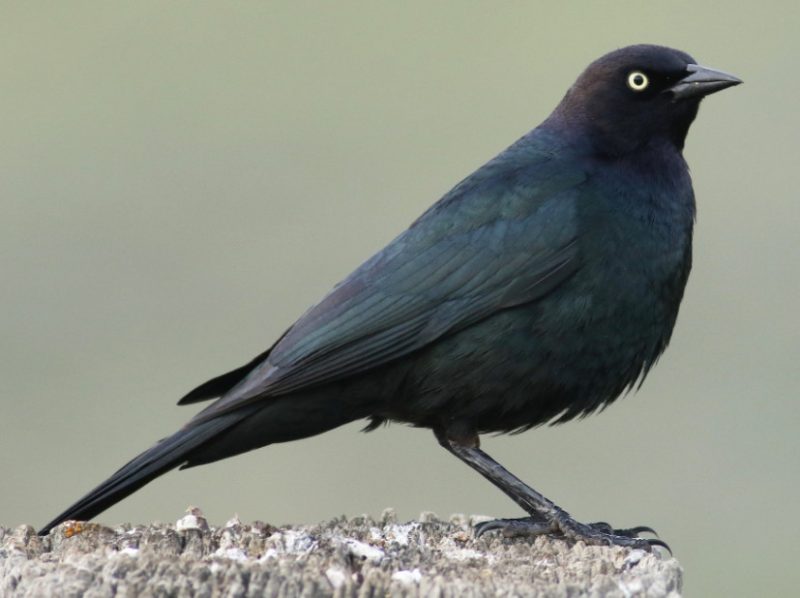
Brewer’s Blackbird is a medium-sized blackbird with a subtle iridescent sheen on its black feathers. Males display a glossy purple-black color with bright yellow eyes, while females are duller grayish-brown with darker wings and tail. Their relatively small size and sleek shape differentiate them from larger grackles.
In Texas, Brewer’s Blackbirds inhabit open fields, farmlands, urban parks, and grasslands. They are ground feeders, often seen foraging in flocks on lawns or agricultural fields. These birds are adaptable and thrive in a variety of habitats, including human-altered landscapes. Their presence increases in winter when they join large mixed-species flocks.
Brewer’s Blackbirds primarily eat seeds, grains, and insects. They forage by walking on the ground, picking food items from the soil or low vegetation. Their diet shifts seasonally, relying more on insects in summer and seeds in colder months. Their bold and social behavior makes them common and noticeable in many parts of Texas.
Yellow-headed Blackbird (Xanthocephalus xanthocephalus)
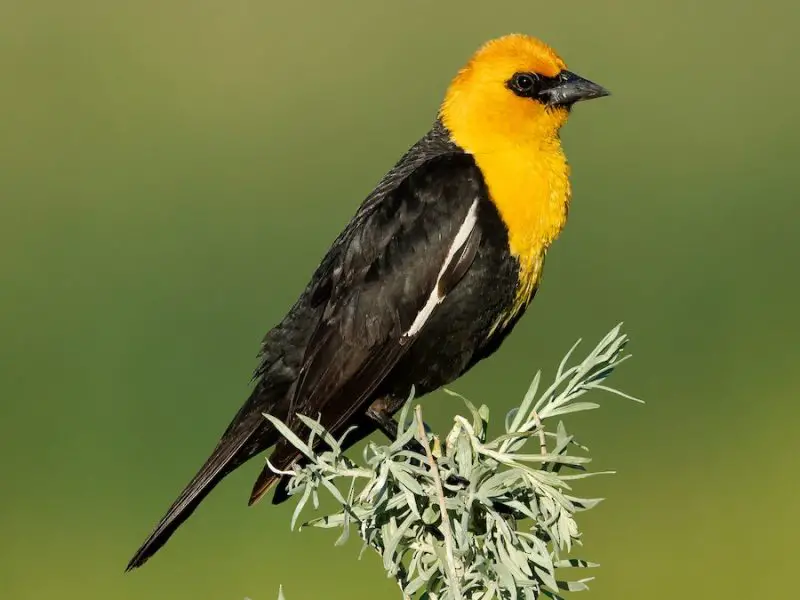
The Yellow-headed Blackbird is a striking species easily identified by its bright yellow head and chest contrasted with a glossy black body. Males exhibit this vivid coloration, while females are duller with brownish bodies and less prominent yellow markings. Their size is similar to other blackbirds, about 8 to 10 inches in length.
These birds favor marshy wetlands and freshwater marshes in Texas, especially during breeding season when males display prominently to attract mates. They nest in dense vegetation near water and often form colonies. Yellow-headed Blackbirds are migratory, spending winters in southern Texas and Mexico and summers further north.
Their diet mainly consists of seeds and insects. They forage by gleaning insects from reeds and cattails or picking seeds from grasses and aquatic plants. Their presence in wetland ecosystems helps control insect populations, and their loud, harsh calls are a common sound in Texas marshlands during breeding season.
Rusty Blackbird (Euphagus carolinus)
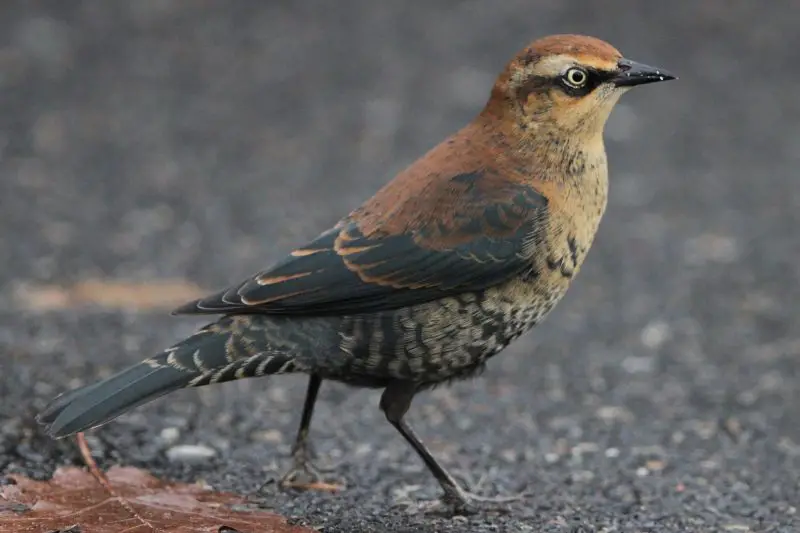
Rusty Blackbirds are medium-sized blackbirds with a somewhat dull black body that appears rusty brown or grayish during non-breeding seasons. Males are darker and more glossy during breeding, while females are generally duller. Their yellowish eyes and somewhat ragged plumage during migration make them distinctive among blackbirds.
In Texas, Rusty Blackbirds are rare but sometimes seen during migration or winter in wooded wetlands, swamps, and flooded forests. They prefer cool, moist habitats rich in insects and aquatic invertebrates. Their populations have been declining, making sightings in Texas more notable and significant for bird watchers.
Their diet is mostly insects, aquatic invertebrates, and seeds found in wetland environments. They forage by probing shallow water or leaf litter for food. Rusty Blackbirds are known to be shy and often stay in small groups, making them less conspicuous than other blackbird species in Texas.
Bronzed Cowbird (Molothrus aeneus)
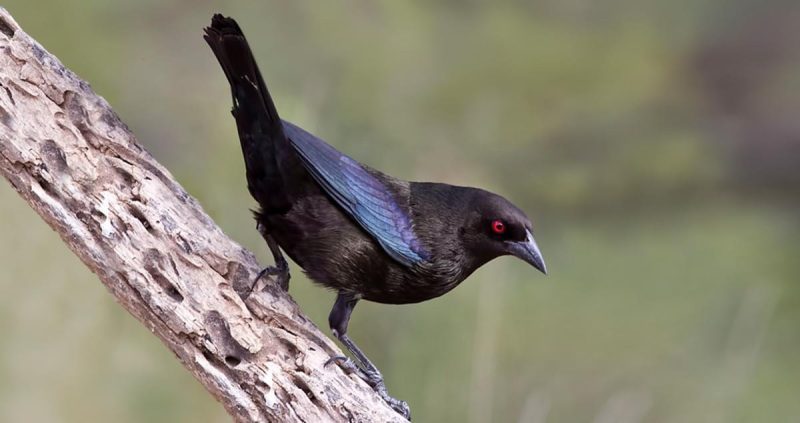
The Bronzed Cowbird resembles the Brown-headed Cowbird but with a more metallic, bronze-colored body and a dark head. Males show this glossy bronze plumage, while females are duller brown. They are about 7 to 8 inches long and have a similar chunky build and short bill. This species is primarily found in southern Texas and Mexico.
Bronzed Cowbirds inhabit open woodlands, brushy areas, and farmlands in Texas, especially near the border with Mexico. Like their Brown-headed relatives, they are brood parasites, laying their eggs in the nests of other bird species. This behavior affects host populations but is a natural part of their life cycle.
Their diet includes seeds, grains, and insects, often foraging on the ground or in low vegetation. They frequently associate with cattle or other large mammals, following them to catch disturbed insects. Their presence in Texas is more localized compared to other cowbird species, but they are an important part of the region’s blackbird diversity.
Shiny Cowbird (Molothrus bonariensis)

The Shiny Cowbird is a small blackbird with a sleek, glossy black body and a slight iridescent sheen, primarily found in southern Texas and parts of Central and South America. Males display the full glossy black plumage, while females tend to be duller brownish with less shine. They have a short, stout bill and a relatively compact size around 7 to 8 inches in length.
In Texas, Shiny Cowbirds are mostly seen in the southern regions, especially in open and semi-open habitats such as fields, pastures, and edge woodlands. They are brood parasites like other cowbirds, laying their eggs in the nests of various small bird species. Their presence is somewhat localized but increasing, possibly due to habitat changes and climate shifts.
Their diet consists largely of seeds, grains, and insects, which they forage on the ground or in low vegetation. They often follow grazing animals, taking advantage of insects stirred up by movement. The Shiny Cowbird’s parasitic reproductive strategy and adaptability make it a unique component of Texas’s blackbird community.
Orchard Oriole (Icterus spurius)
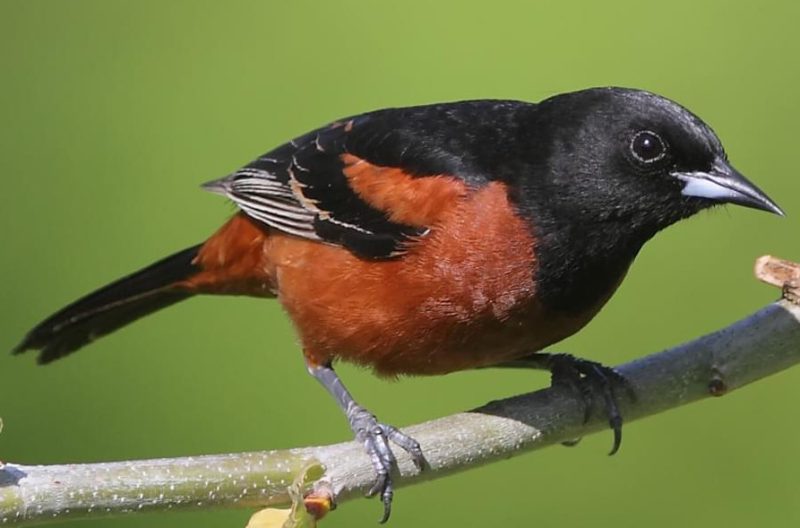
The Orchard Oriole is a small, colorful member of the blackbird family, with males showing a striking chestnut body contrasted by a black head and back. Females are more olive-green with lighter underparts, making them less conspicuous. They are slender birds, about 6 to 7 inches long, with a pointed bill suited for their varied diet.
In Texas, Orchard Orioles are summer residents, favoring open woodlands, orchards, and suburban areas with plenty of trees and shrubs. They build small hanging nests often suspended from thin branches. Their melodic and rich song is a common sound in suitable habitats during breeding season.
These orioles feed on insects, nectar, and fruit. They often forage in tree canopies, gleaning insects from leaves or sipping nectar from flowers. Their presence benefits gardens and orchards by controlling insect pests, and their vibrant colors make them a favorite among bird watchers in Texas.
Hooded Oriole (Icterus cucullatus)
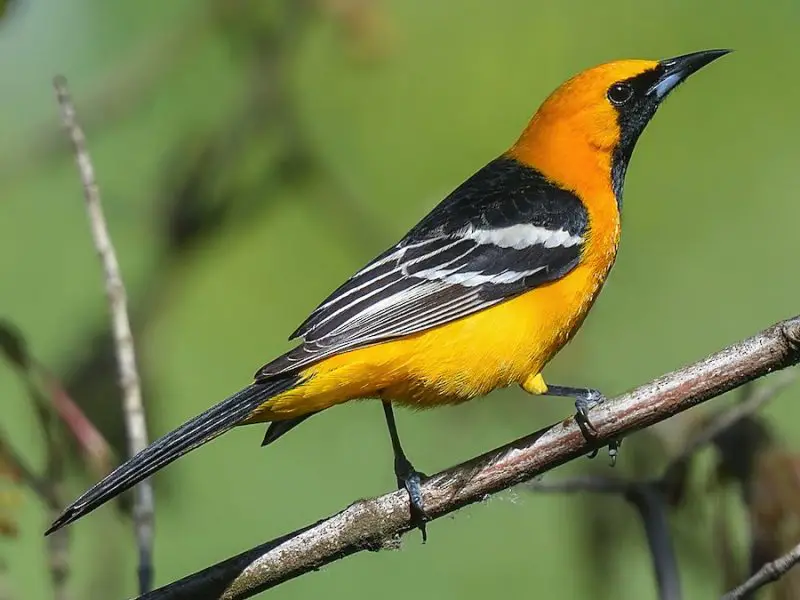
Hooded Orioles are medium-sized orioles notable for their bright orange-yellow bodies and black hoods, wings, and tails in males. Females are duller, mostly yellow-green without the black hood, but share the same slender build and pointed bill. They measure about 7 to 8 inches in length.
These orioles are common in southern Texas, especially in desert-edge habitats, riparian woodlands, and urban areas with palm trees or large shade trees. Hooded Orioles are known for weaving intricate hanging nests from fibers and grasses, often in palm fronds or deciduous trees.
Their diet consists mainly of nectar, fruits, and insects. Hooded Orioles are important pollinators as they visit flowers regularly. They also forage for caterpillars and other insects, contributing to natural pest control. Their bright plumage and lively behavior make them a striking presence in Texas landscapes.
Bullock’s Oriole (Icterus bullockii)

Bullock’s Oriole is a vibrant blackbird with bright orange and black plumage in males, characterized by an orange body, black throat, and white wing bars. Females are lighter, with yellow-orange tones and less black. These birds are medium-sized, about 7 to 8 inches long, and have slender, pointed bills.
In Texas, Bullock’s Orioles breed mainly in northern and western parts of the state, favoring open woodlands, riparian corridors, and parks with deciduous trees. They are migratory, spending winters in Mexico and Central America. Their hanging nests are intricately woven and suspended from tree branches.
Their diet includes insects, nectar, and fruit. They forage actively among foliage, catching insects in flight or gleaning them from leaves. Bullock’s Orioles also feed on tree sap and are important for pollination. Their striking colors and energetic songs make them popular with bird watchers.
Altamira Oriole (Icterus gularis)

The Altamira Oriole is a large, brightly colored oriole with vivid orange-yellow plumage contrasted by a black face, throat, and chest. It is one of the largest orioles found in Texas, measuring about 8 to 9 inches long. Both sexes are similar in appearance, with males slightly brighter.
Altamira Orioles are primarily found in southern Texas, especially along the Rio Grande Valley, in subtropical woodlands, thorn forests, and urban parks with large trees. They build bulky hanging nests, often in tall trees near water. These orioles are territorial and vocal, known for their loud, clear whistles.
Their diet mainly consists of nectar, fruit, and insects. They play an important ecological role by pollinating flowers while feeding and by controlling insect populations. Their bold colors and distinctive calls make them a memorable sight in southern Texas habitats.
Audubon’s Oriole (Icterus graduacauda)

Audubon’s Oriole is a striking bird with bright yellow-orange body plumage and a contrasting black hood and back in males. Females are slightly duller but retain the yellow and black pattern. This medium-sized oriole, about 8 inches long, is easily recognized by its vibrant colors and long tail.
In Texas, Audubon’s Orioles are mainly found in the southern and southwestern parts, inhabiting riparian woodlands, subtropical forests, and dense brush areas. They build hanging nests woven from fibers and often favor tall trees near water. These orioles are territorial during breeding and known for their clear, melodious songs.
Their diet consists largely of nectar, fruit, and insects. They forage actively in tree canopies and shrubs, helping to pollinate flowers while feeding on nectar. Insects provide essential protein, especially during the breeding season. Audubon’s Oriole’s vivid colors and vocal nature make it a favorite for birdwatchers in Texas.
Baltimore Oriole (Icterus galbula)

Baltimore Orioles are well-known for their bright orange bodies, black heads, and white wing bars in males. Females are generally lighter orange or yellowish with grayish backs. They are slender, about 7 to 8 inches long, with a pointed bill adapted for nectar feeding and insect catching.
These orioles migrate to Texas during spring and summer, where they prefer open woodlands, parks, and suburban areas with deciduous trees. Their hanging, woven nests are usually attached to thin branches or wires. Baltimore Orioles are admired for their beautiful, flute-like songs.
Their diet consists mainly of insects, fruit, and nectar. They frequently feed on sugar-water feeders and visit flowering trees. Baltimore Orioles help control insect populations and pollinate plants, making them ecologically valuable in Texas. Their brilliant plumage and cheerful songs add charm to many habitats.
Streak-backed Oriole (Icterus pustulatus)
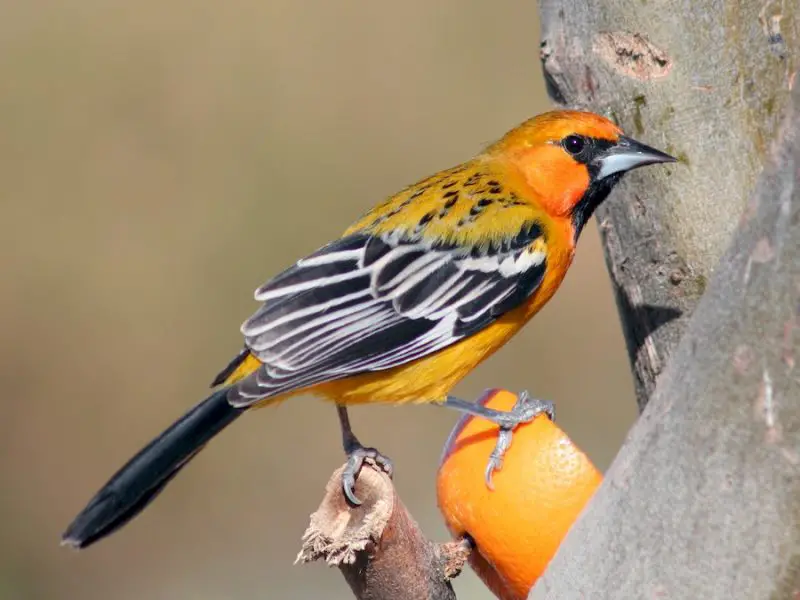
The Streak-backed Oriole is a medium-sized oriole with bright yellow-orange plumage and distinctive black streaks on its back, giving it a unique patterned appearance. Males are brighter with clear streaking, while females are duller but show similar patterns. They measure about 7 to 8 inches long.
In Texas, Streak-backed Orioles are mostly found in the southern regions, especially near the Rio Grande Valley. They inhabit subtropical woodlands, scrublands, and urban parks with dense trees. These birds build hanging nests woven from grasses and fibers, often in thorny shrubs or tall trees.
Their diet includes nectar, insects, and fruit. They are active foragers, gleaning insects from foliage and sipping nectar from flowers. Streak-backed Orioles contribute to pollination and insect control, supporting the health of Texas’s subtropical ecosystems. Their streaked backs make them distinctive among other orioles.
Dark-eyed Junco (Junco hyemalis)

The Dark-eyed Junco is a small, sparrow-like bird commonly seen across North America during winter. It has a slate-gray or brownish body with a white belly, and its “dark eyes” help distinguish it from other juncos. The body color varies by region, with some subspecies showing more brown tones.
In Texas, Dark-eyed Juncos are winter visitors, frequenting forests, woodlands, gardens, and parks. They are ground feeders, often seen hopping on leaf litter or open ground searching for seeds. These birds prefer cool, sheltered areas and are common in suburban and rural settings during colder months.
Their diet mainly consists of seeds, grains, and some insects. They forage by scratching the ground or picking seeds from low plants. Dark-eyed Juncos travel in flocks, sometimes mixed with other small birds, and their soft, musical songs and calls are typical winter sounds in Texas.
Turkey Vulture (Cathartes aura)

Turkey Vultures are large birds with a wingspan of up to 6 feet, easily identified by their dark brown to black feathers and distinctive red, bald heads. They are scavengers, playing a vital role in ecosystems by cleaning up carrion. Their keen sense of smell helps them locate dead animals from high in the sky.
In Texas, Turkey Vultures are widespread and common, inhabiting open areas, forests, and deserts. They are often seen soaring in large groups, using thermals to glide effortlessly while searching for food. They roost communally in tall trees or on cliffs and are highly social outside of feeding.
Their diet consists almost entirely of carrion, which they locate by sight and smell. Turkey Vultures are important for controlling disease by consuming dead animals. Their soaring flight and featherless heads make them unmistakable and an essential part of Texas’s natural landscapes.
Downy Woodpecker (Dryobates pubescens)

The Downy Woodpecker is a small, compact bird with a black-and-white checkered pattern on its back, white underparts, and a small bill. Males have a small red patch on the back of the head, while females lack this feature. Measuring about 6 to 7 inches long, it is the smallest woodpecker in North America.
In Texas, Downy Woodpeckers inhabit woodlands, parks, and suburban areas with plenty of trees. They are commonly found clinging to tree trunks and branches, searching for insects hiding in bark crevices. Their drumming on wood is a typical sound in many Texas forests and neighborhoods.
Their diet mainly consists of insects like beetles and ants, which they extract by pecking and probing tree bark. They also eat seeds and berries, especially in winter. Downy Woodpeckers play an important role in controlling insect populations and maintaining forest health.
American Crow (Corvus brachyrhynchos)
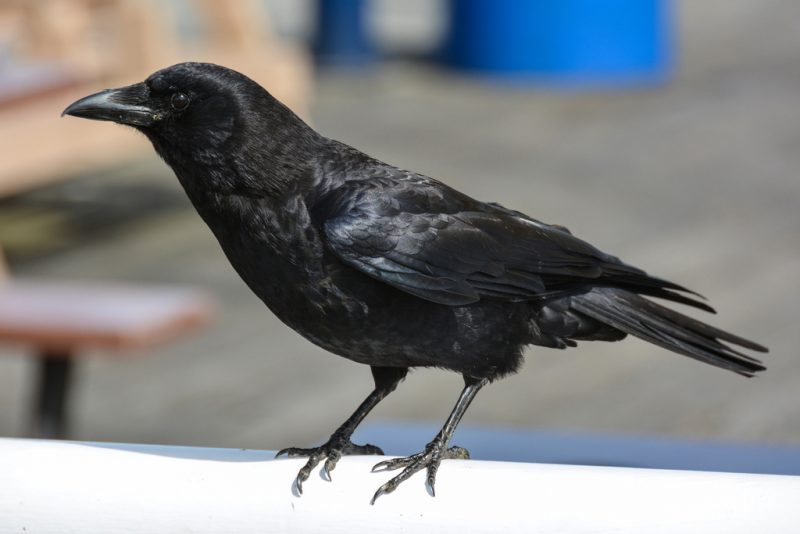
The American Crow is a large, all-black bird with a strong, stout bill and a fan-shaped tail. Measuring about 16 to 21 inches long, it is highly adaptable and intelligent. Their loud, “caw-caw” calls are familiar sounds across Texas.
American Crows are widespread throughout Texas, occupying urban, suburban, and rural environments. They thrive in open woodlands, farmlands, and city parks. Crows are highly social, often seen in large flocks, especially during roosting and foraging.
They are omnivorous, feeding on insects, seeds, fruits, small animals, and human food scraps. Their intelligence allows them to use tools and solve complex problems. American Crows are vital scavengers and ecosystem cleaners across Texas.
Common Raven (Corvus corax)
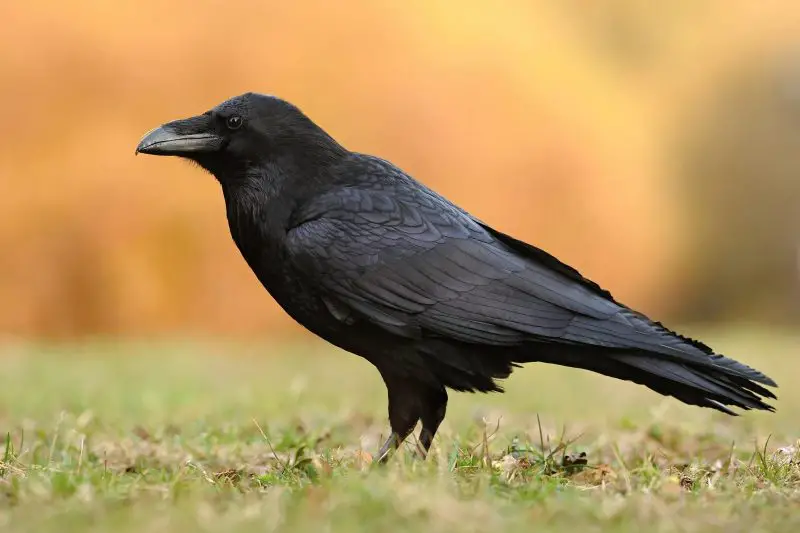
The Common Raven is one of the largest passerine birds, measuring up to 25 inches long with a thick neck and shaggy throat feathers. It is entirely black with a glossy sheen and has a deep, resonant “croak” distinct from the American Crow.
In Texas, Common Ravens inhabit remote areas such as deserts, mountains, and open plains, particularly in western parts of the state. They are less common in urban settings compared to crows. Ravens are known for their aerial acrobatics and complex social behaviors.
Their diet is highly varied, including carrion, small mammals, insects, grains, and occasionally food scraps. Ravens are opportunistic feeders and intelligent problem solvers, playing a key role in nutrient recycling and ecological balance in Texas habitats.
Black Phoebe (Sayornis nigricans)
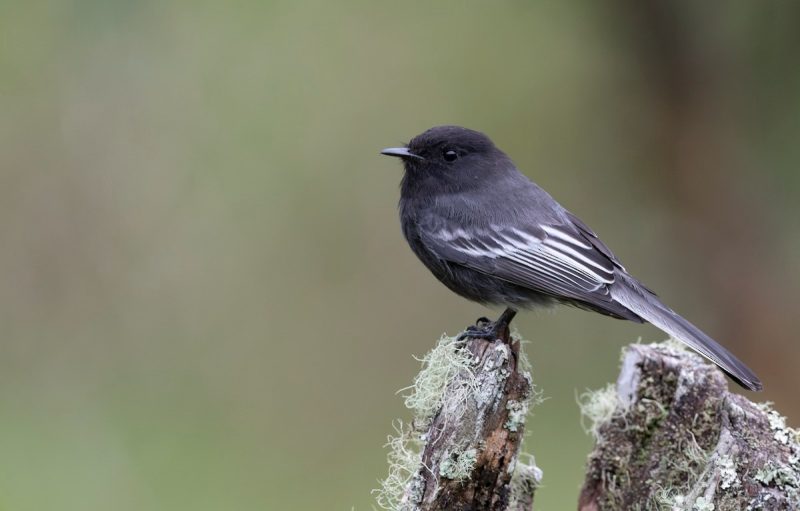
The Black Phoebe is a small flycatcher with a dark gray to black upper body and a contrasting white belly and undertail coverts. It measures about 6 to 7 inches long and is known for its distinctive tail-wagging behavior while perched.
In Texas, Black Phoebes are common near water sources like streams, ponds, and wetlands, especially in southern and central parts of the state. They often perch on low branches or rocks, darting out to catch flying insects before returning to their perch.
Their diet consists mainly of insects such as flies, beetles, and moths, which they catch on the wing. Black Phoebes contribute to insect population control near water bodies and are appreciated for their lively presence and soft, buzzy calls in Texas.


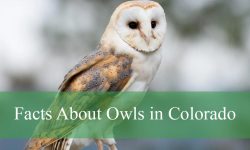
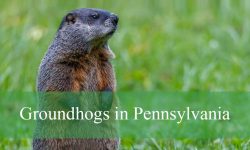


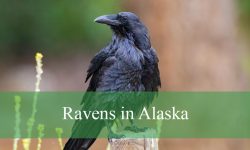
What a wonderful find! Thank you so much for what you have created for the planet.